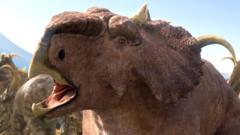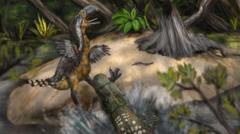Deep within the verdant landscape of Alberta, Canada, lies a stunning prehistoric treasure—a colossal mass grave where thousands of dinosaurs met a tragic fate. Known as the "River of Death," Pipestone Creek serves as a focal point for a group of palaeontologists determined to uncover the mystery behind this 72-million-year-old catastrophe. The excavation began with the powerful strike of a sledgehammer, breaking through a protective rock cover. As the layers of sediment are meticulously removed, a trove of fossilized bones begins to reveal itself.
Leading the excavation is Professor Emily Bamforth, whose team is unearthing the remains of Pachyrhinosaurus, a dinosaur that thrived during the Late Cretaceous period. This creature, measuring around five meters in length and equipped with distinctive horns and a large bony frill, represents a significant find in understanding the age's diverse fauna. The ongoing dig has unveiled an astonishing density of fossils—up to 300 bones per square meter—indicating this site could be one of North America's largest dinosaur graveyards.
Many of these dinosaurs are believed to have been part of a massive herd migrating in search of richer vegetation that once covered this area. The grave site offers a rare snapshot of a singular species, which is nearly unprecedented in the fossil record. This extraordinary degree of detail allows researchers to piece together the ecological puzzle of this ancient ecosystem.
Further exploration takes palaeontologists to the nearby Deadfall Hills, where larger bones, including those of Edmontosaurus, are scattered along the riverbanks. The findings here complement the work being done at Pipestone Creek, constructing a broader picture of these ancient lands and their inhabitants.
Amidst the bounty of fossilized remains, researchers grapple with a pressing question: What led to the sudden demise of so many creatures in this region? Evidence suggests a catastrophic flash flood may have played a central role. Professor Bamforth theorizes that the herd became trapped during a seasonal migration, swept away by violent waters that uprooted trees and displaced boulders.
The pivotal findings at Pipestone Creek and subsequent research in the region continue to illuminate the lives of these long-extinct creatures, providing new insights with each visit. As the skeletal remains whisper stories of their time, palaeontologists are poised to reveal layers of prehistoric knowledge previously shrouded in mystery. Each year they return, the promise of new discoveries beckons—a testament to the endless allure of the ancient world and the secrets it holds within its rocky, complex strata.



















